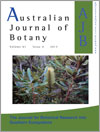Australian Journal of Botany
Volume 61
Number 4 2013
Plant mating systems can vary significantly in both space and time, influencing a range of processes critical for the persistence of plant populations in fragmented landscapes. Spatial and temporal mating-system variation was investigated in Banksia cuneata, a rare bird-pollinated shrub, with substantial spatio-temporal variation observed and a significant reduction in outcrossing found in disturbed populations. Temporal mating-system variation warrants increased consideration in assessing the effects of habitat fragmentation and the undertaking of translocation and restoration programs.
Montane shrub-dominated wetlands are limited by seasonality of climate and low moisture index values at their northern distributional limit. Although landscape features are also of importance, they do not limit these northern occurrences. Predicted climate change and more frequent fires will cause a retraction of this wetland type further south and east.
Wallum is the regionally distinct vegetation of Quaternary dunefields and beach ridge plains along the eastern coast of Australia. Wallum sand masses contain large aquifers, and previous studies have suggested that many of the plant species may be groundwater dependent, although the extent of this dependency is largely unknown. The present study examined the water relations of 15 representative wallum species on the lower north coast of NSW. Comparative differences in water relations could be loosely related to growth forms. A tree, Eucalyptus racemosa subsp. racemosa, and the majority of large shrubs (e.g. Banksia aemula) had low midday xylem water potential, osmotic potential and elasticity, and high water-use efficiency. In contrast, most small and medium shrubs had high midday xylem water potential, osmotic potential and elasticity, and low water-use efficiency. The results suggested that E. racemosa subsp. racemosa is likely to be groundwater dependent, and large shrubs such as B. aemula may also utilise groundwater. Both species are widespread in wallum, and therefore have the potential to play a role in monitoring ecosystem health where aquifers are subject to groundwater extraction.
Fertilisation residues may influence individual and ecosystem aspects. Using the previously fertilized areas (N, P and Ca), we analysed possible leaf structural changes in a small Neotropical savannah shrub. We found that fertiliser residues decreased scleromorphy of the leaves of this species.
Small-scale multi-patches environments were manipulated to investigate the impacts of nitrogen heterogeneity on DNA cytosine methylation and the phenotypic variations of the clonal plant Hierochloe glabra Trin. Nitrogen addition significantly reduced cytosine methylation levels, whereas there were no substantial differences in morphological traits, except for specific leaf area. Furthermore, significant linear regression relationships between cytosine methylation levels and traits relevant to asexual reproduction were found. In conclusion, the higher cytosine-methylation level may activate asexual reproduction to produce more offspring and expand plant populations, possibly helping clonal plants to adapt to heterogeneous habitats.
Native grasses are key components for successful rehabilitation of most post-mining vegetation communities but germination is often low. We investigated 13 native grass species and found that poor germination of selected native grass species was due to (1) low percentage of seed fill, (2) low seed viability of filled seeds and/or (3) seed dormancy. Most of these species were found to exhibit at least one form of dormancy and half were found to have two dormancy mechanisms.
The wattles (Acacia s.s.) form an ideal group for biological study for at least the following four reasons: (1) they are almost restricted to a single continent, although widespread across it; (2) this continent has a varied climate and environments to which the genus has adapted with great success; (3) Acacia s.s. comprises many species (~1020); and (4) makes up almost one-third of a well-defined monophyletic group, the mimosoid legumes, which comprise ~3300 species spread across the world. The present study focused on wood anatomy, which reflects the evolution, ecology, physiology and environmental conditions in which the species grow. The wood anatomy of this genus has been surprisingly neglected, possibly having been overshadowed by Australia’s other most diverse genus Eucalyptus, now grown and exploited worldwide.
In this paper, we examine how isolated paddock trees of buloke affect soil moisture and nutrients in their near vicinity and how such effects impact on buloke sapling performance. Mature trees altered most soil nutrients and soil moisture, but sapling performance was best outside the canopy. Competition from the native understorey also appeared important for saplings. Enhancement plantings around isolated paddock trees should occur outside the canopy of mature buloke to enhance establishment success.
The Kimberley region of Western Australia has a comparatively rich mistletoe flora. Most species are widespread and some are common, but the North Kimberley bioregion is notable for having the richest mistletoe flora and the highest number of rare species. Fire is eroding some distributions. Nevertheless, some populations of most species occur in safe refugia.
In this study, we confirmed the physical dormancy in seeds of Cassytha filiformis. Thus, this study is the first report of the confirmed occurrence of physical dormancy in the magnoliids clade. Evolutionary aspects of physical dormancy in Cassytha (Lauraceae) are discussed.




